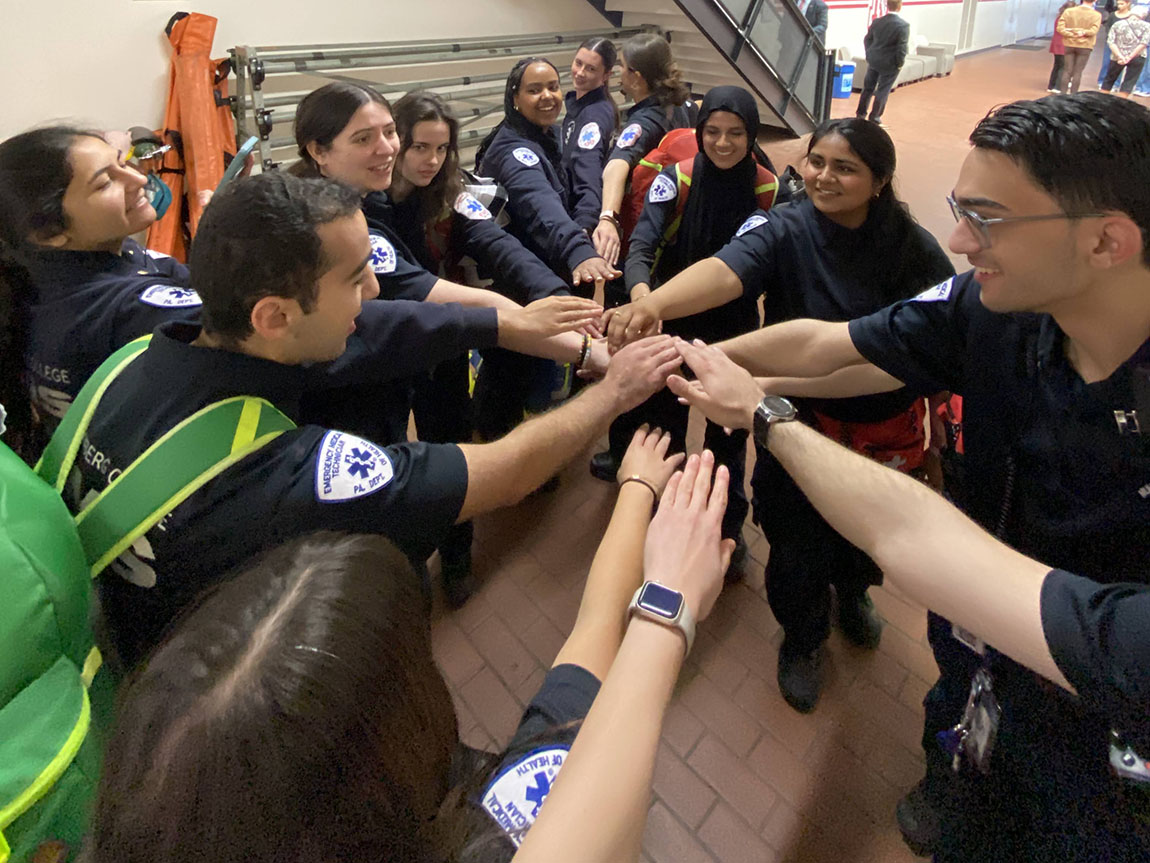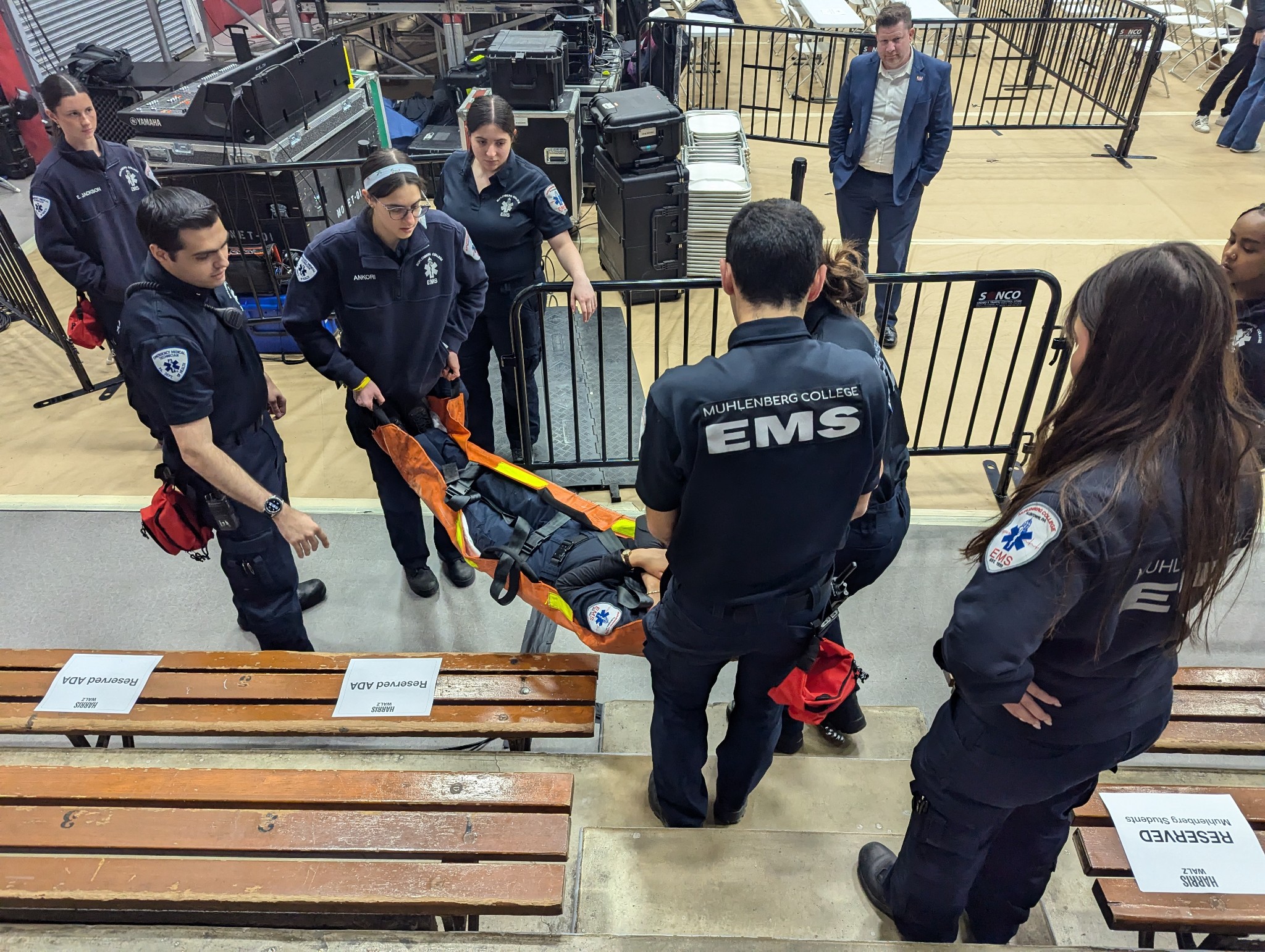What Muhlenberg College EMS Students Learned From a Major Political Rally on Campus
We worked alongside Secret Service agents and other security professionals to provide medical services and assist with emergency preparedness for this event that brought thousands of people to campus.By: Gabe Kanter-Goodell ’25 Monday, November 11, 2024 09:08 AM
 Muhlenberg College EMS students huddle ahead of the rally they were working. Photos courtesy Muhlenberg College EMS
Muhlenberg College EMS students huddle ahead of the rally they were working. Photos courtesy Muhlenberg College EMS On Monday, November 4, the College Democrats hosted Vice President Kamala Harris for a rally on campus. The student-run Muhlenberg College EMS (MCEMS) — an apolitical organization that does not endorse any person or political matter — played an important role in providing medical services and emergency preparedness for the event’s attendees. Here, Captain Gabe Kanter-Goodell ’25 (pictured), a public health major, explains how MCEMS students coordinated with other security services during the planning stages and the rally itself.
On Monday, November 4, the College Democrats hosted Vice President Kamala Harris for a rally on campus. The student-run Muhlenberg College EMS (MCEMS) — an apolitical organization that does not endorse any person or political matter — played an important role in providing medical services and emergency preparedness for the event’s attendees. Here, Captain Gabe Kanter-Goodell ’25 (pictured), a public health major, explains how MCEMS students coordinated with other security services during the planning stages and the rally itself.
Muhlenberg College EMS was notified about the rally Sunday morning by Campus Police, the Secret Service and Allentown EMS (AEMS). We determined with AEMS that we would be the primary internal response to the event — responsible for the attendees’ safety within the Life Sports Center’s confines — and that they would manage the exterior and treatment areas.
We immediately began to facilitate staffing, develop an incident command structure and create an emergency action plan, commonly called an EAP. We met with the Secret Service site lead to discuss the venue layout and determine their protocols for medical responses. We developed a dynamic staffing model, which allowed us to allocate resources in response to crowd movement. We began to organize our equipment: equipment to be with each crew, as well as patient movement equipment and more intensive treatment equipment to be placed in central areas for easy access.

We held a late-night briefing with our crews to ensure the EAP was understood and followed. We also were sure to brief and train on the unique challenges of Memorial Hall, namely bleacher extrication and how to operate within large crowds.
On the day of the rally, we got to work at about 8 a.m. to meet with AEMS and Lehigh Valley Health Network’s EMS Fellow, who was in attendance at the treatment site. We strategically placed crews in central areas, and I was in the command post with the heads of the other external agencies.
While working the event, MCEMS learned how to better integrate with the larger emergency response system and improved our communication, coordination and disaster management planning with external agencies. Furthermore, one of our goals this year is to improve our relationship with AEMS. This event strengthened our bond and improved relations with their leadership.
“This experience provided a unique opportunity to apply my theoretical knowledge to a real-world scenario. Under pressure, I had to think critically, make rapid decisions and coordinate multiple teams and resources. For the first time, I was able to apply these skills beyond a training environment.”
—MCEMS Captain Gabe Kanter-Goodell ’25
Throughout the experience, we interacted a lot with the Secret Service. It was an incredible honor to work alongside them and to get an inside look into the robust and sophisticated planning that goes into an event like this. It was also an incredible experience to get to know the agents, hear a little about their stories and realize how down-to-earth they are.
As an EMT, and now a commanding officer, I’ve undergone rigorous training in emergency management through the Federal Emergency Management Agency. While EMS primarily focuses on direct patient care, a crucial component is preparedness for large-scale incidents. Large gatherings like this rally are akin to managing a disaster, and we treat them under the same principles of organization, resource allocation and risk mitigation.
This experience provided a unique opportunity to apply my theoretical knowledge to a real-world scenario. Under pressure, I had to think critically, make rapid decisions and coordinate multiple teams and resources. For the first time, I was able to apply these skills beyond a training environment. I can say with confidence that nowhere outside of a collegiate EMS environment would someone my age be entrusted with this tremendous responsibility, and I am immensely grateful for this opportunity.

